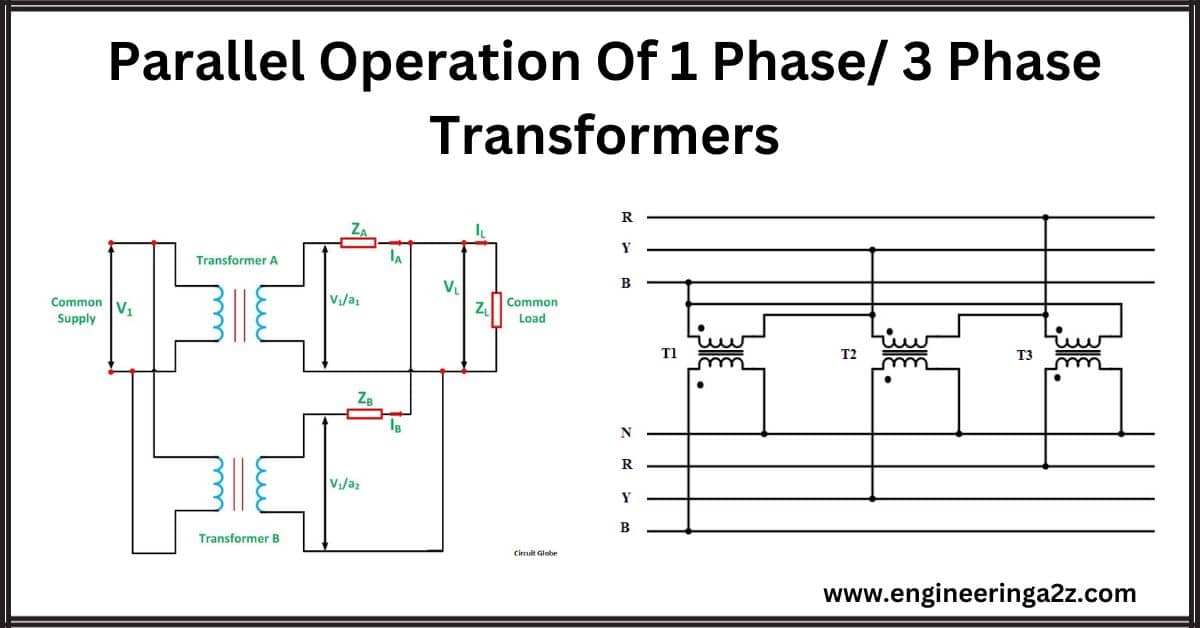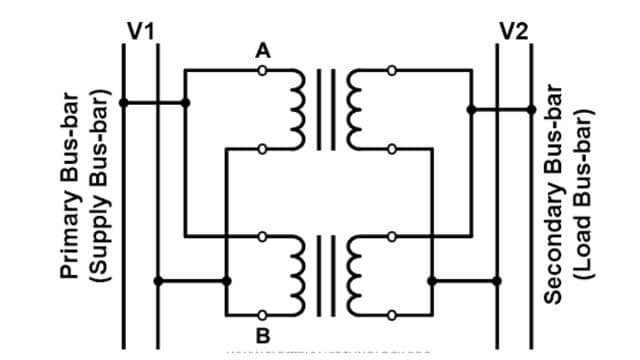
Table of Contents
Introduction
Transformers are devices that help provide electricity to a city or area. Sometimes, the power needed is more than what a single transformer can handle. In such situations, instead of using one big transformer, we connect multiple smaller ones together in what we call “parallel operation.”
Imagine you have two transformers, and they’re both connected to the same power source. This means they’re working together to supply electricity to the city. It’s like having two helping hands instead of just one to get the job done.
This parallel operation of transformers is a way to make sure there’s enough power for everyone, especially when the demand is high. It’s like teaming up to share the workload and keep the electricity flowing smoothly.
Parallel Operation of Single-Phase Transformers
Parallel operation of single-phase transformers involves connecting multiple transformers together to work as a team, supplying electrical power to a common load. Here’s a simple description of how the parallel operation of single-phase transformers works:
Imagine you have two single-phase transformers, Transformer A and Transformer B. They both have a primary winding (where power comes in) and a secondary winding (where power goes out).

- Same Voltage Rating: First, make sure that both Transformer A and Transformer B have the same voltage rating on their primary and secondary sides. This means they can handle the same amount of electrical voltage.
- Matching Polarity: Ensure that the polarity of both transformers is the same. Polarity refers to the direction of electric flow. If the polarities are different, it’s like having one transformer running backward.
- Same Voltage Source: Connect the primary windings of both transformers to the same voltage source, like your city’s power grid. This means they both get power from the same place.
- Same Load: Connect the secondary windings of both transformers to a common load, like houses or buildings in a neighborhood. This ensures that they are both working together to power the same area.
- Balanced Sharing: The transformers will share the load proportionally based on their capacity. If Transformer A can handle more power, it will take on a larger share of the load, and Transformer B will handle the rest. It’s like two friends sharing the work, with one doing more if they are stronger.
- Safety: Install protective devices, like fuses and circuit breakers, to prevent any issues in case of an overload or fault.
By connecting these transformers in parallel, you ensure a reliable and efficient power supply to the connected load, even when the demand for electricity varies. It’s like having two cars on standby to ensure you always have a ride when you need it.
Conditions for Parallel Operation of Single-Phase Transformers
Here are the conditions for parallel operation of single-phase transformers explained in simpler terms:
Necessary Conditions:
- Same Polarity: The transformers you want to connect in parallel must have the same direction of electric flow. If they don’t, it’s like trying to swim in opposite directions in a pool; it leads to problems.
- Equal Voltage Ratios: The voltage ratios of these transformers must be identical. This means they should handle and deliver electricity in the same way. If not, it’s like trying to pour water from two differently sized cups at the same rate, which can lead to unusual flows of electricity and waste power.
Desirable Conditions (for efficiency):
- Equal Internal Impedance: The transformers should have similar internal resistance and capacity to handle electric flow. It’s like making sure all the pipes in a plumbing system are equally wide, so water flows smoothly.
- Matching Reactances and Resistances: The ratio of the transformer’s ability to resist electrical changes to its ability to conduct electricity should be the same for all the transformers. This ensures they all work together efficiently, sharing the electrical workload based on their capacity. It’s like ensuring everyone in a group project does their fair share of the work, and no one slacks off.
Parallel Operation of Three-Phase Transformers
Here’s a simpler explanation of the conditions for parallel operation of three-phase transformers, including additional requirements:
- Matching Phase Sequence: The electrical phases in both transformers must operate in the same order. Think of it like ensuring all the traffic lights in an intersection switch colors at the same time, or it could cause confusion.
- Equal Phase Displacement: The time delay or shift between the input and output voltages of the transformers should be the same. Imagine you have two dancers moving to the same beat; they need to be perfectly in sync.
- Same Transformer Type: All three transformers used in the group must be of the same type, either core-type or shell-type. It’s like using only one type of battery in your TV remote to make it work correctly.
- Consistent Voltage Ratio: When calculating voltage ratios, consider the line voltages (the electricity that flows between phases). Make sure this voltage ratio remains the same. Think of it like ensuring all your kitchen appliances operate at the same voltage, so they don’t get damaged or work improperly.

To give an example, if you have primary (V1) and secondary (V2) terminal voltages, and you’re connecting the transformers in a Star-to-Delta (Y-Δ) configuration, you need to ensure that the voltage ratio is not just based on the number of turns per phase but also matches the actual line voltages.

Following these conditions ensures that when you connect multiple three-phase transformers in parallel, they work together effectively to provide a reliable and balanced supply of electricity without causing any confusion or problems.
Conditions for Parallel Operation of Three-Phase Transformers
Here are the conditions for the parallel operation of three-phase transformers explained in simpler terms:
- Matching Polarity: The transformers you connect in parallel must have the same electric flow direction. Think of it as making sure all the wheels on a car are turning in the same direction; otherwise, the car won’t move smoothly.
- Identical Voltage Ratings: The primary and secondary voltage ratings of the transformers should be the same. This means they can handle and deliver electricity at the same levels. It’s like making sure all your gadgets use the same type of batteries; otherwise, they won’t work properly.
- Similar Reactance-to-Resistance Ratios: The balance between a transformer’s ability to handle electrical changes and its capacity to conduct electricity should be equal for all the transformers. It’s like ensuring that different-sized water pipes in a house have the right mix so that water flows evenly from all taps.
- Matching Phase Sequence: The order in which the electrical phases of the transformers operate must be the same. It’s like ensuring that all the musicians in a band play their instruments in sync; otherwise, it’ll sound messy.
- Consistent Phase Shift: The difference in timing between the input and output voltages should be the same for all the transformers. Imagine you have different watches, they all need to show at the same time or you’ll get confused.
- Same Vector Group: All the transformers should belong to the same category or group. Think of it as making sure all your computer software is compatible; otherwise, they won’t work well together.
Necessity Of Parallel Operation Of Transformers
- When we use electricity, sometimes we use more than what one transformer can handle. Imagine you have a big bucket, but you need more water than it can hold. So, you connect another bucket to it. This way, you can have enough water for your needs.
- Sometimes, we don’t have a really big bucket (transformer) to provide all the water (electricity) we need. Instead of waiting for a big one, we can use two or more smaller buckets (transformers) together. It’s like using two smaller water tanks to hold enough water.
- Think of transformers as backup generators. If one stops working, having more than one ensures that the electricity doesn’t go out completely. It’s like having spare light bulbs in case one burns out.
- If you need to move these transformers to a place that’s far away, it’s easier and cheaper to transport smaller ones, just like carrying small bags of groceries instead of one huge bag.
Conditions For Parallel Operation
When you connect multiple transformers together to work in parallel, there are some important rules to follow:
- Same Voltage Ratio: All the transformers should have the same voltage ratio. Imagine you have different-sized water pipes connected to the same bucket. If the sizes are different, the water won’t flow evenly.
- Equal Impedance: Each transformer should have the same relative resistance and capacity to handle electric flow. It’s like making sure all the lanes on a highway are equally wide; otherwise, traffic won’t move smoothly.
- Matching Voltage Drops: If you have transformers of different sizes, they should all share the load equally. This means the bigger transformer should do its fair share of the work. It’s like ensuring that everyone in a group project does their part.
- Same Polarity: Transformers should have the same direction of electric flow. If they don’t, it’s like having cars on a roundabout driving in opposite directions; it causes problems.
- Identical Phase Sequence: This applies to multi-phase transformers. They should have their phases in the same order; otherwise, they won’t work well together.
- Similar Short-Circuit Impedance: While it’s hard to make them exactly the same, the transformers should have roughly similar abilities to handle electrical faults. It’s like ensuring all the players on a team have similar skills, even if they’re not identical.
Following these rules ensures that the transformers can work together efficiently and effectively to provide the electricity needed.
Frequently Asked Questions (FAQs)
What is the parallel operation of a transformer?
When you need to provide more electricity than one transformer can handle, you can connect multiple transformers together to share the workload. This is like having multiple friends help carry a heavy load when one person can’t do it alone. It ensures there’s enough power for everything, especially when some things need more electricity than others.
What is the parallel operation of a 3-phase transformer?
Parallel operation of a 3-phase transformer is like having three chefs in a kitchen working together to cook a big meal. Instead of one chef doing all the cooking, they share the work. Similarly, multiple transformers team up to provide electricity to a place where one transformer alone might not be enough. They ensure there’s enough power for everything that needs electricity, like homes and businesses.
Can a transformer convert single-phase to three-phase?
No, a transformer can’t convert single-phase to three-phase. Transformers only change the voltage, not the number of electrical phases.
What are the two advantages of parallel operation of transformer?
1. Increased Capacity: Transformers working in parallel provide more electricity, like having extra helping hands when you need to power a lot of things.
2. Reliability: If one transformer has a problem, the others can still supply power, ensuring a continuous electricity supply.
Read Also:
- Output Equation of Transformer
- High Voltage Direct Current (HVDC) Transmission
- Three Phase Transformer | Construction & Working
- Transformer | Construction, Working Principle | Advantages & Disadvantages
- Single Phase Induction Motor | Double Revolving Field Theory





Leave a Reply